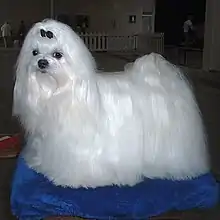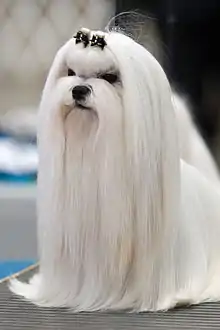Maltese dog
The Maltese is a breed of dog in the toy group. It is thought to have originated in south-central Europe from dogs of spitz type.[3] Despite the name, it has no verified historic or scientific connection to the island of Malta.[4]: 347 [5]
| Maltese | |||||||||||||||||||||||||||
|---|---|---|---|---|---|---|---|---|---|---|---|---|---|---|---|---|---|---|---|---|---|---|---|---|---|---|---|
 Maltese groomed with overcoat | |||||||||||||||||||||||||||
| Origin | Central Mediterranean Region[1] | ||||||||||||||||||||||||||
| |||||||||||||||||||||||||||
| |||||||||||||||||||||||||||
| Dog (domestic dog) | |||||||||||||||||||||||||||
.tif.jpg.webp)

It traditionally has a silky, pure-white coat, hanging ears and a tail that curves over its back, and weighs up to 3.6 kilograms (8 lb).[6]
History
Little is known about the origin and spread of the modern Maltese. It probably originated from spitz-type dogs in south-central Europe, where it may at first have resembled the modern Pomeranian.[3]
In 1837 Edwin Landseer painted The Lion Dog from Malta: The Last of his Tribe, a portrait of a Maltese named Quiz commissioned by Queen Victoria as a birthday present for her mother, the Duchess of Kent, whose dog it was.[4]: 345 [7]
A white dog was shown as a "Maltese Lion Dog" at the first Westminster Kennel Club Dog Show in New York City in 1877.[8] The Maltese was recognised as a breed by the American Kennel Club in 1888.[8] It was definitively accepted by the Fédération Cynologique Internationale under the patronage of Italy in 1955,[9] at the annual meeting in Interlaken, Switzerland. Parti-coloured and solid-coloured dogs were accepted in the show ring from 1902 until 1913 in England, and as late as 1950 in Victoria, Australia.
Melitaie
The Maltese dog was a lapdog favoured by both the ancient Greeks and Romans, especially their children, and appears on amphorae with the word Μελιταίε (Melitaie).[10] References to the dog can also be found in Ancient Greek and Roman literature.[11] Aristotle mentions the dog around 370 BC. Some ancient writers attribute its origin to the island of Malta in the Mediterranean, called Melita in Latin, others claim it to be from the island of Mljet off the coast of Croatia, also called Melita in Latin.[12]: 63 [4]: 347
Pliny suggests the dog as having taken its name from the Adriatic island Mljet (also Melita in Latin),[13] however Strabo, in the early first century AD, identifies the breed as originating from the Mediterranean island of Malta.[14]
During the first century, the Roman poet Martial wrote descriptive verses to a lap dog named "Issa" owned by his friend Publius.[15] It is proposed that Issa was a Maltese dog, and various sources link Martial's friend Publius with the Roman Governor Publius of Malta,[16] though others do not identify him.[17]
John Caius, physician to Queen Elizabeth I, also claimed that Callimachus was referring to the island of Melita "in the Sicilian strait" (Malta).[18] This claim is often repeated, especially by English writers.[19] The dog's links to Malta are mentioned in the writings of Abbé Jean Quintin, Secretary to the Grand Master of the Knights of Malta Philippe Villiers de L'Isle-Adam, in his work Insulae Melitae Descriptio.[20][21]
English writers in the early twentieth century also gave Malta as the place of origin of the breed.[22]
Characteristics

The coat is dense, glossy, silky and shiny, falling heavily along the body without curls or an undercoat.[1] The colour is pure white, however a pale ivory tinge is permitted.[1] Adult weight is usually 3–4 kg (7–9 lb).[1] Bitches are about 20–23 cm (8–9 in) tall, dogs slightly more.[1]
The Maltese does not shed.[23]: 59 Like other white dogs, it may show tear-stains.[24]: 297 [25]: 41 [26]
Use
The Maltese is kept for companionship, for ornament, or for competitive exhibition. It is ranked 59th of 79 breeds assessed for intelligence by Stanley Coren.[27]
See also
References
| Wikimedia Commons has media related to Maltese. |
- FCI-Standard N° 65: Maltese. Fédération Cynologique Internationale. Accessed November 2021.
- "Maltese". Animal Planet dog breed directory. Archived from the original on 2011-07-26. Retrieved 2009-08-29.
- MacKinnon, M.; Belanger, K. (2006). "Ch.5". In Snyder, L.; Moore, E. (eds.). Dogs and People in Social, Working, Economic or Symbolic Interaction. Oxbow Books. p. 43. ISBN 978-1-78570-399-7.
- Rawdon Briggs Lee ([1899]). A History and Description of the Modern Dogs of Great Britain and Ireland (non-sporting division). London: The Queen & Field (Horace Cox) Ltd. (also available here).
- Cramer, John Anthony (1828). Geographical and Historical Description of Ancient Greece. Clarendon Press. pp. 45–46. Retrieved 2009-04-16.
- "Maltese | breed of dog". Encyclopedia Britannica. Retrieved 2021-07-03.
- The Lion-Dog of Malta – The Last of His Tribe. New York: The Metropolitan Museum of Art. Accessed November 2021.
- David Alderton (2010). Maltese. American Kennel Club. Accessed November 2021.
- FCI breeds nomenclature: Maltese. Fédération Cynologique Internationale. Accessed November 2021.
- Johnson, Helen M. (1919). "The Portrayal of the Dog on Greek Vases". The Classical World. XII (27): 209–213. doi:10.2307/4387846. JSTOR 4387846.
- Busuttil, J. (1969). "The Maltese Dog". Greece & Rome. Cambridge University Press. 16 (2): 205–208. doi:10.1017/S0017383500017058.
- Lillian C. Raymond-Mallock (1907). The Up-to-date Toy Dog: The History, Points and Standards of English Toy Spaniels, Japanese Spaniels, Pomeranians, Toy Terriers, Pugs, Pekinese, Griffon Bruxellois, Maltese and Italian Greyhounds .... Battle Creek, Michigan:The Dogdom Publishing Company.
- C. Plinius Secundus. The Historie of the World. Vol. Book III. Translated by Philemon Holland. pp. 50–71.
- Jean Quintin d'Autun Insulae Melitae Descriptio, 1536, vii, "Huic insulae Strabo nobiles illos, adagio, non minus quam medicinis..."
- Serpell, James (1996). In the company of animals: a study of human-animal relationships. Cambridge University Press. p. 47. ISBN 0-521-57779-9. Retrieved 2009-04-16. Note:refers to a "lap dog"
- Blarney, Edwin Reginald; Charles Topping Inglee; American Kennel Club (1949). The complete dog book. The care, handling, and feeding of dogs; and Pure bred dogs; the recognized breeds and standards. Garden City Publishing Co., Inc. p. 622.
- Vioque, Guillermo Galán (2002). Martial, book VII: a commentary. Translated by J. J. Zoltowski. BRILL. p. 467. ISBN 90-04-12338-5. Retrieved 2009-04-16.
- Wentworth (1911). Toy Dogs and Their Ancestors: Including the History and Management of Toy Spaniels, Pekingese, Japanese, and Pomeranians. Duckworth. Retrieved 2009-04-16.
- Bryant, Jacob, Esq. (1807). A New system, or, An Analysis of Antient Mythology: Wherein an Attempt is Made to Divest Tradition of Fable and to Reduce the Truth to its Original Purity. Vol. V (3rd ed.). London: J. Walker. p. 359. Retrieved 2009-04-16.
- Jean Quintin d'Autun Insulae Melitae Descriptio (1536).
- "The Maltese dog: a toy for ancient royalty". Times of Malta. Retrieved 29 March 2020.
- Drury, W.E. (1903). "Ch.59-The Maltese". British Dogs, Their Points, Selection, and Show Preparation. Charles Scribner's Sons. p. 574.
- David Alderton (2010). The Dog Selector: How to Choose the Right Dog for You. Hauppauge, New York: Barron's. ISBN 9780764163654.
- Robert Leighton (1910). Dogs and all about them. London; New York: Cassell and Company, Ltd.
- The Maltese Dog - Complete Anthology of the Dog. [s.l.]: Vintage Dog Books.
- "Tear Staining". www.americanmaltese.org. Retrieved 2021-03-16.
- Coren, Stanley (2006). The Intelligence of Dogs. London: Pocket Books. p. 124. ISBN 978-1-4165-0287-6.